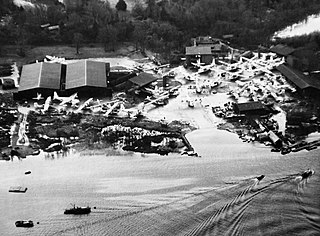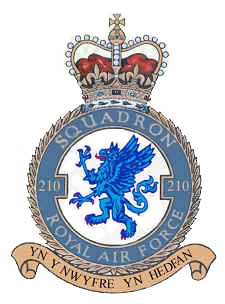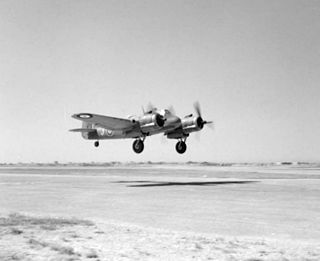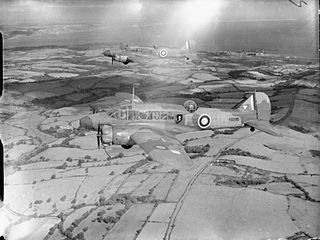
No. 206 Squadron is a Test and Evaluation Squadron of the Royal Air Force. Until 2005 it was employed in the maritime patrol role with the Nimrod MR.2 at RAF Kinloss, Moray. It was announced in December 2004 that 206 Squadron would disband on 1 April 2005, with half of its crews being redistributed to Nos. 120 and 201 Squadrons, also stationed at Kinloss. This was a part of the UK Defence Review called Delivering Security in a Changing World; the Nimrod MR.2 fleet was reduced in number from 21 to 16 as a consequence.
No. 119 Squadron RAF was a squadron of the Royal Air Force, flying with RAF Coastal Command during the Second World War. It was the only RAF unit flying the Short G class and Short C class flying boats.

No. 461 Squadron was a Royal Australian Air Force maritime patrol squadron during World War II which operated under Royal Air Force control flying in Europe and over the Atlantic. The squadron was formed in 1942 and was disbanded in mid-1945, just after the end of the war in Europe. Personnel were drawn from many countries of the British Empire, although the majority were Australians. Throughout the war, the squadron was credited with destroying a total of six German U-boats, and operated mainly in the Bay of Biscay and Atlantic.
No. 283 Squadron was a Royal Air Force squadron that served during the Second world war in the air-sea rescue (ASR) mission role while flying Supermarine Walruses and both in ASR and the anti-submarine patrol role while flying Vickers Warwicks.
No. 191 Squadron was a Royal Air Force squadron. During World War I it was a non-operational night training unit, while during World War II it was engaged in maritime reconnaissance.

No. 190 Squadron was a Royal Air Force squadron with a relatively short existence, but a very broad career. It served as a trainer squadron during the first World War and as convoy escort, airborne support and transport squadron during World War II.
No. 61 Squadron was a squadron of the Royal Air Force. It was first formed as a fighter squadron of the British Royal Flying Corps during the First World War. It was reformed in 1937 as a bomber squadron of the Royal Air Force and served in the Second World War and after, until disbanded in 1958.

No. 500 Squadron AAF was a Royal Air Force flying squadron. It was initially formed in 1931 as a Special Reserve squadron and in 1936 became part of the Auxiliary Air Force, at this time based at Manston and Detling.

Royal Air Force Castle Archdale or more simply RAF Castle Archdale, also known for a while as RAF Lough Erne is a former Royal Air Force station used for flying boats by the RAF and the Royal Canadian Air Force in County Fermanagh, Northern Ireland.
No. 262 Squadron RAF was an anti-submarine patrol squadron of the Royal Air Force between 1942 and 1945.

No. 205 Squadron was a Royal Air Force unit formed on 1 April 1918. Prior to this it had existed as No. 5 Squadron of the Royal Naval Air Service (RNAS). In 1929, it became the first RAF squadron to be permanently based in Singapore, taking as its motto Pertama di Malaya. No. 205 Squadron operated during the Second World War and the Cold War before disbanding on 31 October 1971.

No. 210 Squadron was a Royal Air Force unit established in the First World War. Disbanded and reformed a number of times in the ensuing years, it operated as a fighter squadron during the First World War and as a maritime patrol squadron during the Spanish Civil War, the Second World War and the Cold War before it was last deactivated in 1971.
No. 228 Squadron RAF was a squadron of the Royal Air Force active at various times between 1918 and 1964. It spent the greatest part of its existence flying over water, doing so in the First, and Second World Wars and beyond, performing anti-submarine, reconnaissance and air-sea rescue tasks.

No. 235 Squadron RAF was an anti-submarine squadron of the Royal Air Force in World War I and in World War II served as a squadron in RAF Coastal Command.
No. 204 Squadron was a Royal Air Force unit first formed in March 1915 as No.4 Squadron Royal Naval Air Service.

Number 209 Squadron of the British Royal Air Force was originally formed from a nucleus of "Naval Eight" on 1 February 1917 at Saint-Pol-sur-Mer, France, as No. 9 Squadron Royal Naval Air Service (RNAS) and saw active service in both World Wars, the Korean War and in Malaya. The use of the squadron number ceased in 1968 and it has not been reused since by an RAF squadron. However the number, badge and motto is in current service within the RAF Air Cadets at 209 Squadron ATC in Nottinghamshire.

No. 321 (Dutch) Squadron RAF was a unit of the Royal Air Force during the Second World War formed from the personnel of the Marineluchtvaartdienst (MLD), the Royal Netherlands Naval Air Service.
No. 248 Squadron was a squadron of the Royal Air Force, active immediately after World War I, and again during World War II.
No. 240 Squadron RAF was a Royal Air Force flying boat and seaplane squadron during World War I, World War II and up to 1959. It was then reformed as a strategic missile squadron, serving thus till 1963.

35 Squadron SAAF is a squadron of the South African Air Force. It is a maritime patrol and transport squadron.












